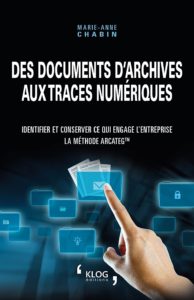Company information: Is there a pilot in the plane?
Information governance: which method?
In April 2018, a book was published that serves as a sort of compass to help you find your way through the maze of corporate information governance, with a specific method based on decades of experience in the field.
Indeed, the author, Marie-Anne Chabin, is a recognised specialist in archiving and a key figure in the records management in France.
Standardised in 2001 by theISO, records management is a set of practices aimed at effective management of "records" (a term that is difficult to translate into French without truncating its meaning), which the French version of the standard defines as "information created, received and preserved as evidence and assets by a natural or legal person in the exercise of its legal obligations or the conduct of operations related to its activity".

Corporate information: what are we talking about?
Marie-Anne Chabin synthesises in her new book, entitled "From archival documents to digital tracesIn her new book, entitled "From Archival Records to Digital Traces", Marie-Anne Chabin synthesises a body of knowledge and methods of direct interest to the (existing or non-existent) corporate information management strategy, which she defines as follows:
"Corporate information is that which is issued, received and managed in the name of the company, as a legal person.It isthe documents and data that engage the company's responsibility, not only towards the outside world but also internally or with subcontractors".
A useful reminder: not all information circulating in the company is targeted in a governance strategy. Fortunately... Because taking an interest in corporate information is already a challenge in itself, as the author reminds us in the first part of the book: traces, data, content, documents? On what physical media? Paper, electronic? In which case, what about storage? What are the related flows, responsibilities and roles?
Information contexts and issues
The first part of the book deals with information in all its forms, with salutary reminders in this area, and in contexts that are of particular interest to corporate information: operational, legal and regulatory, patrimonial, etc.
Didactic, the book contains numerous boxes clarifying fundamental notions in terms of information governance, such as electronic signature, EDM and archiving, authenticity and integrity, or redundancy and security.
Considering information as it arises
The method itself, discussed in the second part of the book, is interesting in that it deals with information from the moment it is created or collected, like the records management standard, which offers the advantage of governance of information throughout its life, from its creation to its destruction or permanent preservation.
Because taking care to manage company information as soon as it takes shape in the operational activity means establishing rules and good practices in terms of processing, management, storage and archiving at the very beginning of its life cycle, which makes it possible to consider the strategic issues linked to it upstream. These issues are recalled in the second chapter of the first part: "Three universal requirements".
Many topics related to corporate information are therefore covered in this book, including the very topical RGPD.
In this regard, where do you stand? Compliant? Not compliant?
Read more
Facebook
Google+ page
Twitter
LinkedIn
Are you interested in this topic?